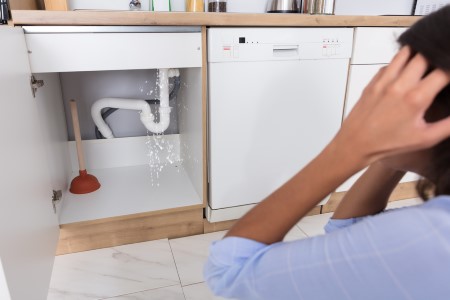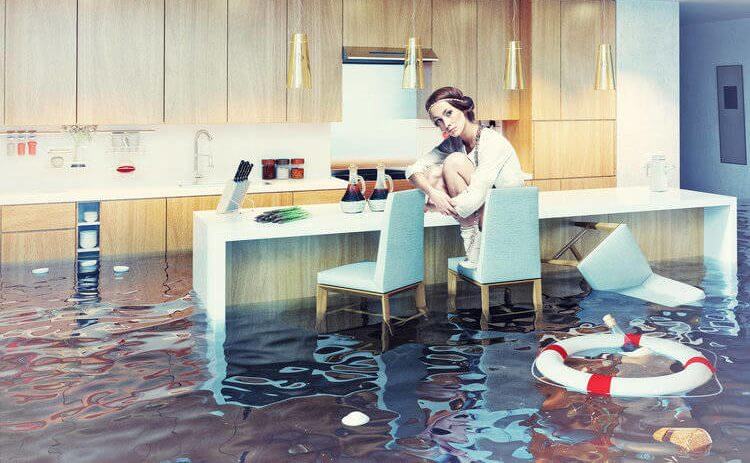On this page below you can get additional really good material in regards to Water Damage in Kitchen.

The kitchen is the room where a lot of water task takes place. You can rarely do anything without making use of water in the kitchen, from food preparation, cleaning, and doing the meals.
Therefore, inspecting your cooking area periodically is a necessity. This is due to the fact that it has a greater opportunity of obtaining water damage due to the appliances you make use of there.
When damaged, these appliances that control water could make your kitchen messy and affect the structure of your building in the long run.
So, let's have a look at some causes of the water damage in the kitchen and what you need to keep an eye out for.
Some Sources Of Water Problems in the Kitchen area
These are a few causes of water damage in the cooking area.
Faulty Drainpipe Pipeline
Drain Pipelines are needed parts of our homes, especially in our washrooms as well as kitchen areas. They obtain defective by obtaining obstructed, broken, and ruptured. Or worse, they can be mistakenly or loosely attached; whichever the situation may be, it can be an extreme issue.
Malfunctioning drain pipelines can trigger water damage and, because of this, create mold growth and also disfigure the appearance of your wall. It can also make the damaged area look unpleasant.
For that reason, it is advisable constantly to check to make sure that all the pipes remain in good condition and obtain a sound pipes system to maintain and also repair any kind of problems.
Faulty Kitchen Area Sink
The cooking area sink is an important and also most utilized part of the kitchen. Thus it is prone to water damage; problems such as blocked pipelines, dripping pipes, and also faulty faucets.
These problems can be bothersome, specifically when one is busy in the kitchen area. It doesn't just occur without offering a sign or a clue. Here are some signs to understand when your sink is not all right
- When draining water right into the skin makes a gurgling sound and produces air bubbles while experiencing the sink. It indicates that something is obstructing the pipes of the sink.
- Another indication of an obstructed drainpipe is the slow-moving activity of water. Usually, water goes through a sink immediately, so if you begin observing hold-up, there is a clog in the pipelines.
- The next sign is an offensive smell; this shows that the pipes are blocked, as well as stale food is piling in the pipes. This problem needs a quick fix, so the scent does not surpass your residence.
- Dripping taps and also pipelines additionally can be a concern. It makes your kitchen location messy and wet, especially when dripping from the pipelines. And also if it is trickling from the tap, it brings about water wastefulness.
- These are the significant problems that can take place to your kitchen area sink. One means to quit this damages is by guaranteeing that food bits do not get into the pipelines. You are additionally examining the faucets and also pipelines as well as guaranteeing that it is correctly repaired and in good condition.
Dripping Dishwashing machine
Dishwashing machines make life in the kitchen easier. It is an optional kitchen area home appliance and, when readily available, can be a resource of water damage. Additionally, like various other makers, it will develop mistakes gradually, despite upkeep.
Among the faults is dripping with the door or below the dishwasher. These mistakes develop as a result of age, fractures, wrong use, loosened links to pipes, and so on.
Mistakes because of age come from continual use. Consequently, the door leaks as a result of closing and opening up.
Faults from the incorrect usage might trigger water damage by introducing splits to it. For this reason, it is recommended to adhere to the hands-on guide of the dish washer to avoid this specific damage.
The leaks under the dish washer can come from splits in the gasket, hose pipe, and loosened or wrong link to pipes or drains.
This kind of leakage often goes undetected and can be there for a very long time. However, as a result of the time structure, it could harm the floor as well as create mold growth.
A lot more so, the longer the water stays, you will see the warping of the flooring where the dish washer is. When inspecting if your dish washer leaks, this is a great indicator to look out for. Spotting and fixing this promptly prevents major water damage to your floor covering.Bottom Line
Looking out for problems in your cooking area can be tasking but needed. It makes your job there easier as well as much safer.
The reasons detailed above are only a few elements to think about, specifically if your cooking area has a whole lot of appliances.
So get an expert plumbing solution to find about and also look for any kind of damage and get them repaired.
It makes your kitchen location damp and also unpleasant, specifically when trickling from the pipelines. And also if it is trickling from the tap, it leads to water wastefulness.
It is an optional cooking area device and also, when readily available, can be a resource of water damage. A lot more so, the longer the water remains, you will discover the warping of the floor where the dishwasher is. Spotting and repairing this on time protects against significant water damage to your floor covering.
WAYS TO PROTECT YOUR KITCHEN FROM WATER DAMAGE
The kitchen is one of the most significant rooms in your house, as it is a multipurpose room wherein you can do your cooking and cleaning. Nowadays, homeowners tend to ignore the problems under their sink or appliances because of their busy schedules. However, most household floods occur due to plumbing and appliance failure. One of the most common scenarios that cause water damage to your kitchen is when the dishwasher malfunctions and floods gallons of water.
Water damage in your kitchen can cause several problems, including cosmetic damage, mold growth, and even an unpleasant smell. Often, if you fail to neglect the problem, there are always consequences. This article will help you protect your kitchen from water damage.
Common Causes of Water damage in your kitchen
- Pipe problems are the most common source of water leaks under your sink. If homeowners ignore this issue, it will burst and flood the kitchen.
- Dishwasher leaks can be a source of water damage in your kitchen. An old, broken, and defective dishwasher can cause leaks, damage to your floor, and even mold growth.
- Refrigerator leaks can cause water damage in your kitchen, as sometimes melted ice from defrosting can cause leaks. Furthermore, if your refrigerator has internal problems, it is very likely to cause water damage.
- Back-splash and sink caulking can cause discoloration and water damage to your countertop tiles.
Ways to Protect Your Kitchen From Water Damage
Regular maintenance
The most important thing you can do to protect your kitchen from water damage is to inspect the sinks, drains, and pipes, as well as the kitchen appliances, regularly. As with the sink, check for missing or deteriorated caulk. Remove the old caulk and clean the area thoroughly and re-seal it with fresh silicone. Furthermore, sweep the drain regularly, empty the filter and dispose of the debris in the garbage, and inspect the supply lines and valve for cracks.
Check your appliances
Check the user’s manual for instruction and proper use of every water-related appliance installed in your kitchen. For the dishwasher, check this procedure to prevent the dishwasher from flooding your kitchen. Check the appliances that need water, such as the coffee maker, ice maker, and water cooler, as they can become the cause of water damage in your kitchen. You may call a professional to check and repair damaged appliances and professional restoration for water damage clean-up.
Garbage clean-up
Fats, oil, and grease are common in the kitchen. Pouring them down the drain can cause clogs and sewage backup, which may result in significant kitchen water damage. If your kitchen sink is clogged, use a solution of hot water, baking soda, and vinegar to unclog the fats and oils in the pipes. Also, make sure to throw out the debris in the trash and clean the sink properly using paper towels for greases and oil and soap or bleach solution for the sink itself.
Shut off your water line
Make sure to shut off your main water line, especially if you're away and having some flood issue. As mentioned, dishwasher leaks are one of the most common culprits of water damage in the kitchen. So, make sure to only use the dishwasher if someone is at home and available to attend in case a problem arises.
Furthermore, it is also important that every member of your household knows where the shut-off valves are located. So in case of an emergency, they can mitigate the damage by turning off the water source.
Install leak detectors
One of the best ways to catch water damage before it could even cause serious damage to your home or business is by installing a water or leak detector. A leak detector monitors the flow of water through a pipeline, can detect moisture in the air for molds, and tracks the water temperature. Also, it can shut off your water line in case of an emergency. Install leak detectors under the kitchen sink, near the dishwasher and refrigerator.
https://superiorrestore.com/7-ways-to-protect-your-kitchen-from-water-damage/

I'm very fascinated by Most Common Causes of Residential Water Damage and I'm hoping you enjoyed the new entry. Are you aware of someone else who is in the market for the topic? Take a moment to share it. I thank you for reading our article about How To Prevent Water Damage To Your Kitchen.
Apply Now
Comments on “Water Damage in the Kitchen: The 5 Most Common Types and Solutions”